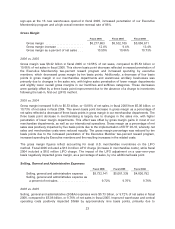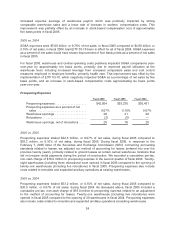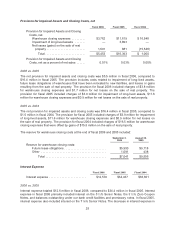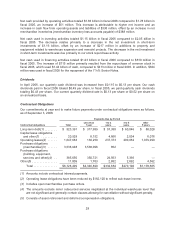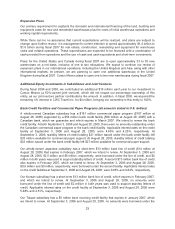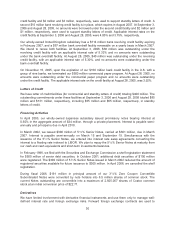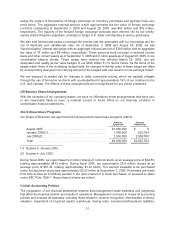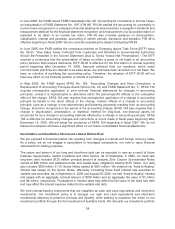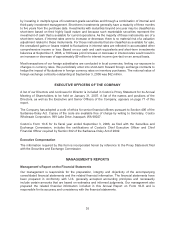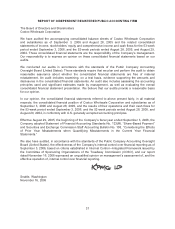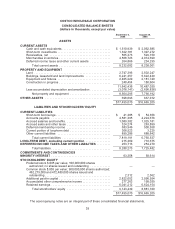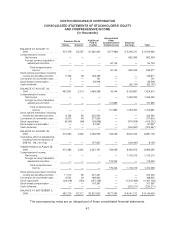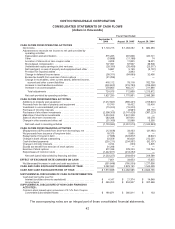Costco 2006 Annual Report Download - page 35
Download and view the complete annual report
Please find page 35 of the 2006 Costco annual report below. You can navigate through the pages in the report by either clicking on the pages listed below, or by using the keyword search tool below to find specific information within the annual report.We provide estimates for warehouse closing costs based on applicable U.S. generally accepted
accounting principles. Future circumstances may result in actual closing costs or the amount
recognized upon the sale of the property to differ substantially from the original estimates.
Insurance/Self Insurance Liabilities
We use a combination of insurance and self-insurance mechanisms, including a wholly-owned captive
insurance entity and participation in a reinsurance pool, to provide for potential liabilities for workers’
compensation, general liability, property damage, director and officers’ liability, vehicle liability and
employee health care benefits. Liabilities associated with the risks that we retain are not discounted
and are estimated, in part, by considering historical claims experience and evaluations of outside
expertise, demographic factors, severity factors and other actuarial assumptions. The estimated
accruals for these liabilities could be significantly affected if future occurrences and claims differ from
these assumptions and historical trends.
Stock–Based Compensation
We account for stock–based compensation in accordance with the fair value recognition provisions of
Statement of Financial Accounting Standards (SFAS) No. 123R. We use the Black–Scholes option–
pricing model, which requires the input of subjective assumptions. These assumptions include: estimating
the length of time employees will retain their vested stock options before exercising them (expected
term); the estimated volatility of our common stock price over the expected term (volatility), and the
number of options that will ultimately not complete their vesting requirements (forfeitures). Changes in
these assumptions can materially affect the estimate of fair value of stock–based compensation. In the
fourth quarter of fiscal 2006, we ceased the granting of stock options in favor of restricted stock units.
Income Taxes
The determination of our provision for income taxes requires significant judgment, the use of estimates,
and the interpretation and application of complex tax laws. Significant judgment is required in
assessing, among other things, the timing and amounts of deductible and taxable items. We establish
reserves when, despite our belief that our tax return positions are fully supportable, we believe that
certain positions may be successfully challenged. When facts and circumstances change, we adjust
these reserves through our provision for income taxes.
Recent Accounting Pronouncements
In September 2006, the SEC issued Staff Accounting Bulletin No. 108, “Considering the Effects of Prior
Year Misstatements when Quantifying Misstatements in the Current Year Financial Statements” (SAB
108). SAB 108 addresses how the effects of prior-year uncorrected misstatements should be
considered when quantifying misstatements in current-year financial statements. SAB 108 requires an
entity to quantify misstatements using a balance sheet and income-statement approach and to
evaluate whether either approach results in quantifying an error that is material in light of relevant
quantitative and qualitative factors. We early-adopted SAB 108 as of August 29, 2005, the beginning of
our fiscal year. See Note 11 to the consolidated financial statements included in Item 8 of this report for
further discussion.
In September 2006, the FASB issued Statement of Financial Accounting Standards No. 157, “Fair
Value Measurements” (SFAS 157). SFAS 157 defines fair value, establishes a framework for
measuring fair value and expands disclosures about fair-value measurements required under other
accounting pronouncements but does not change existing guidance as to whether or not an instrument
is carried at fair value. SFAS 157 is effective for our fiscal year 2008. We are currently evaluating the
impact of adopting SFAS 157.
33


